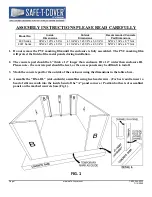
19
Sixteen characters are available for the file name, so when saving custom presets to the PC software
folder outside the Versarray™ Pro 218 Sub, keep that limitation in mind for the file name, and put the
important descriptors first in the file name.
If a Factory Preset has been customized, then type in your desired name and use that to save the file
into DSP memory.
Recall
(Preset)
function loads a DSP file from the on-board memory into the DSP system in the
power amp, and makes it the active working Preset settings for the Versarray™ Pro 218 Sub system.
See Fig. 9.
Fig. 9
The Recall function only brings in the Preset level of parameters, if there was a different set of Project
settings involved with that file, then the appropriate Project file from the PC software Program folder
will also need to be loaded into the Versarray™ Pro 218 Sub DSP system as the next step.
All the Crest Factory Presets use the same basic settings, and thus, can be interchanged by merely
changing the Presets or Recalling from memory.
If setting the system up for network use from now on, see the sub-section titled
Setting a Cabinet Up
for Network Use Only
, in section 4 below.
Signal Flow Chart Group B
This chart shows the signal flow through the Versarray™ Pro 218 Sub DSP system.
It provides a indicator in the form of an
Input Clip Limiter,
which shows input stage electrical clipping.
Gain within the DSP system has been set so as to avoid the signal from clipping the input significantly
before the internal processes reach compression and limiting. Re-adjustment of the internal gain
structure will require monitoring this indicator to assure that you are not clipping the input stage
instead of engaging the appropriate levels of internal compression and limiting.
Input Source is displayed, and is controlled at the View page section 2, located just below the Signal
Flow Chart Group at the left side of the Window.
Two muting points are accessible directly from this flow chart, as shown by the light green “X”s on the
loudspeaker symbol block, see Fig. 10
















































